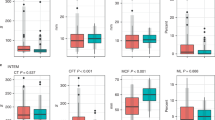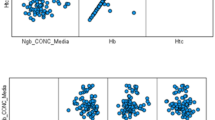Abstract
Background
Umbilical cord blood is used for the testing of various parameters in newborns. However, data on its applicability for hemostasis assays is insufficient.
Objective
To evaluate whether umbilical cord blood can be used for standard tests, thromboelastometry and thrombodynamics for preterm and term newborns.
Methods
187 newborns were included in the study. Blood was taken from the umbilical cord and by venipuncture of the newborn. Clotting times, fibrinogen, D-dimer, thromboelastometry and thrombodynamics were measured.
Results
Clotting times and fibrinogen indicated a hypocoagulable shift, while thromboelastometry and thrombodynamics showed a hypercoagulable shift in hemostasis in umbilical cord blood compared to newborn blood. D-dimer indicated an enhanced process of thrombus lysis in newborn blood compared to cord blood. Collecting blood into a tube with the addition of a contact pathway inhibitor did not significantly change the global assay parameters in either umbilical cord blood or newborn blood. In the thrombodynamics assay, spontaneous clotting was detected but suppressed by the addition of a tissue factor inhibitor.
Conclusions
Hemostasis in cord and newborn blood differs for both global and standard tests. Hypercoagulability in newborns registered with the global assay thrombodynamics is associated with the presence of tissue factor in the blood.
Impact statement
-
1.
We found a hypercoagulation shift in newborns compared with the adult references, possibly due to the presence of tissue factor in blood.
-
2.
Blood coagulation is enhanced in cord blood compared with blood sampled from the vein of a newborn according to thromboelastometry and thrombodynamics assays.
-
3.
Clotting times and fibrinogen concentrations in cord blood differ from these parameters in newborn blood.
-
4.
Studying of the (patho)physiological features of hemostasis in newborns should consider differences in cord blood and vein sampled blood.
This is a preview of subscription content, access via your institution
Access options
Subscribe to this journal
Receive 14 print issues and online access
$259.00 per year
only $18.50 per issue
Buy this article
- Purchase on SpringerLink
- Instant access to full article PDF
Prices may be subject to local taxes which are calculated during checkout




Similar content being viewed by others
Data availability
The datasets generated during and/or analyzed during the current study are available from the corresponding author upon reasonable request.
References
Monagle, P. et al. Developmental haemostasis. Thromb. Haemost. 95, 362–372 (2006).
Andrew, M. et al. Development of the human coagulation system in the full-term infant. Blood 70, 165–172 (1987).
Andrew, M. et al. Development of the human coagulation system in the healthy premature infant. Blood 72, 1651–1657 (1988).
Monagle, P. & Massicotte, P. Developmental haemostasis: Secondary haemostasis. Semin. Fetal Neonatal. Med. 16, 294–300 (2011).
Andrew, M. et al. Maturation of the hemostatic system during childhood. Blood 80, 1998–2005 (1992).
Schneider, D. M., von Tempelhoff, G. F., Herrle, B. & Heilmann, L. Maternal and cord blood hemostasis at delivery. J. Perinat. Med. 25, 55–61 (1997).
Bleyer, W. A., Hakami, N. & Shepard, T. H. The development of hemostasis in the human fetus and newborn infant. J. Pediatr. 79, 838–853 (1971).
Koltsova, E. M. et al. Impaired platelet activity and hypercoagulation in healthy term and moderately preterm newborns during the early neonatal period. Pediatr. Res. 85, 63–71 (2019).
Blajchman, M. A. An overview of the mechanism of action of antithrombin and its inherited deficiency states. Blood Coagul. Fibrinolysis 5, 5–12 (1994).
Mitsiakos, G. et al. Neonatal haemostatic parameters in correlation to gestational age and birth weight. Int. J. Lab. Hematol. 44, 952–958 (2022).
Lippi, G. et al. Routine coagulation tests in newborn and young infants. J. Thromb. Thrombolysis 24, 153–155 (2007).
Tay, S. P., Cheong, S. K. & Boo, N. Y. Circulating tissue factor, tissue factor pathway inhibitor and D-dimer in umbilical cord blood of normal term neonates and adult plasma. Blood Coagul. Fibrinolysis 14, 125–129 (2003).
Knöfler, R. et al. Molecular Markers of the Endothelium, the Coagulation and the Fibrinolytic Systems in Healthy Newborns. Semin Thromb. Hemost. 24, 453–461 (1998).
Khalilov, Z. İ., Ünsal, A. & Altuntaş, N. The D-dimer reference intervals in healty term newborns. Transfus. Apher. Sci. 61, 103493 (2022).
Hudson, I. R. et al. Increased concentrations of D-dimers in newborn infants. Arch. Dis. Child 65, 383–384 (1990).
Nako, Y., Tomomasa, T. & Morikawa, A. Plasma thrombomodulin level in newborn infants with and without perinatal asphyxia. Acta Paediatr. 86, 91–95 (1997).
Murtha, A. Umbilical venous d-dimer concentrations with and without labor. Obstet. Gynecol. 92, 184–186 (1998).
Katsaras, G. Ν et al. The use of thromboelastography (TEG) and rotational thromboelastometry (ROTEM) in neonates: a systematic review. Eur. J. Pediatr. 180, 3455–3470 (2021).
Murphy, C. A. et al. The role of the calibrated automated thrombogram in neonates: describing mechanisms of neonatal haemostasis and evaluating haemostatic drugs. Eur. J. Pediatr. 181, 23–33 (2022).
Lipets, E. et al. Circulating contact-pathway-activating microparticles together with factors IXa and XIa induce spontaneous clotting in plasma of hematology and cardiologic patients. PLoS One 9, e87692 (2014).
Neary, E. et al. Coagulation indices in very preterm infants from cord blood and postnatal samples. J. Throm Haemost. 13, 2021–2030 (2015).
Raffaeli, G. et al. Thromboelastographic profiles of healthy very low birthweight infants serially during their first month. Arch. Dis. Child Fetal Neonatal Ed. 105, 412–418 (2020).
Strauss, T. et al. Clot formation of neonates tested by thromboelastography correlates with gestational age. Thromb. Haemost. 103, 344–350 (2010).
Wiegele, M. et al. Establishing reference ranges of cord blood: point-of-care hemostatic function assessment in preterm and term neonates. Pediatr. Res 90, 452–458 (2021).
Nielsen, S. T. et al. Coagulation parameters in the newborn and infant – the Copenhagen Baby Heart and COMPARE studies. Clin. Chem. Lab. Med. 60, 261–270 (2021).
Raffaeli, G. et al. Is placental blood a reliable source for the evaluation of neonatal hemostasis at birth? Transfusion 60, 1069–1077 (2020).
Whiting, D. & DiNardo, J. A. TEG and ROTEM: Technology and clinical applications. Am. J. Hematol. 89, 228–232 (2014).
Koltsova, E. M. et al. Determination of fibrin clot growth and spatial thrombin propagation in the presence of different types of phospholipid surfaces. Platelets 32, 1031–1037 (2021).
Balandina, A. N. et al. Thrombodynamics-A new global hemostasis assay for heparin monitoring in patients under the anticoagulant treatment. PLoS One 13, e0199900 (2018).
Lipets, E. N. et al. Use of Thrombodynamics for revealing the participation of platelet, erythrocyte, endothelial, and monocyte microparticles in coagulation activation and propagation. PLoS One 15, 1–24 (2020).
Ovanesov, M. V., Ananyeva, N. M., Panteleev, M. A., Ataullakhanov, F. I. & Saenko, E. L. Initiation and propagation of coagulation from tissue factor-bearing cell monolayers to plasma: initiator cells do not regulate spatial growth rate. J. Thromb. Haemost. 3, 321–331 (2005).
Gosselin, R. C. & Marlar, R. A. Preanalytical Variables in Coagulation Testing: Setting the Stage for Accurate Results. Semin Thromb. Hemost. 45, 433–448 (2019).
Dashkevich, N. M. et al. Effect of pre-analytical conditions on the thrombodynamics assay. Thromb. Res. 133, 472–476 (2014).
Yis, O. M., Bugdayci, G., Pehlivan, M. B., Yildiz, R. N. & Alisik, M. Analytical performance evaluation of Sysmex CS-2500 and Stago STA Compact. Blood Coagul. Fibrinolysis 31, 324–329 (2020).
Achey, M. A. et al. The Developing Balance of Thrombosis and Hemorrhage in Pediatric Surgery: Clinical Implications of Age-Related Changes in Hemostasis. Clin. Appl Thromb. Hemost. 26, 107602962092909 (2020).
Gursoy, T. et al. Thrombin activatable fibrinolysis inhibitor activity (TAFIa) levels in neonates with meconium-stained amniotic fluid. J. Matern Fetal Neonat. Med. 21, 123–128 (2008).
Nellenbach, K. A. et al. Comparison of Neonatal and Adult Fibrin Clot Properties between Porcine and Human Plasma. Anesthesiology 132, 1091–1101 (2020).
Al-Biltagi, M. et al. Plasma D-dimer level in early and late-onset neonatal sepsis. World J. Crit. Care Med 11, 139–148 (2022).
Schweintzger, S. et al. Microparticles in newborn cord blood: Slight elevation after normal delivery. Thromb. Res. 128, 62–67 (2011).
Korbal, P., Słomka, A., Sadowska-Krawczenko, I. & Żekanowska, E. Evaluation of tissue factor bearing microparticles in the cord blood of preterm and term newborns. Thromb. Res. 153, 95–96 (2017).
Sinauridze, E. I. et al. Thrombodynamics, a new global coagulation test: Measurement of heparin efficiency. Talanta 180, 282–291 (2018).
Haidl, H. et al. New insights into neonatal coagulation: normal clot formation despite lower intra-clot thrombin levels. Pediatr. Res. 86, 719–724 (2019).
Grabowski, E. F. et al. Comparison of Tissue Factor Pathway in Human Umbilical Vein and Adult Saphenous Vein Endothelial Cells: Implications for Newborn Hemostasis and for Laboratory Models of Endothelial Cell Function. Pediatr. Res. 46, 742–742 (1999).
Uszyński, M., Żekanowska, E., Uszyński, W., Kuczyński, J. & Żyliński, A. Microparticles (MPs), tissue factor (TF) and tissue factor inhibitor (TFPI) in cord blood plasma. A preliminary study and literature survey of procoagulant properties of MPs. Eur. J. Obstetr Gynecol. Reprod. Biol. 158, 37–41 (2011).
Funding
Russian Science Foundation, grant number 22-15-00164.
Author information
Authors and Affiliations
Contributions
Conceptualization, A.N.B. and N.K.T.; methodology, E.M.K.; formal analysis, E.M.K. and A.N.B.; investigation, E.M.K., B.V.A., M.A.S., E.N.L, L.A.T., A.L.K., E.N.B.; data curation, B.V.A., M.A.S.; writing – original draft preparation, E.M.K., A.N.B.; writing – review and editing, N.K.T., E.N.B, M.A.S. and L.V.K.; visualization, A.N.B. and E.M.K.; supervision, F.I.A., V.V.Z., D.N.D and G.T.S; project administration, B.V.A.; funding acquisition, A.N.B. All authors have read and agreed to the published version of the manuscript.
Corresponding author
Ethics declarations
Competing interests
FIA is a former employee and cofounder of Hemacore, LLC. Hemacore LLC holds several patents and patent applications related to the diagnostic use of spatial clot growth and has developed the assay under the trade name Thrombodynamics®. Hemacore LLC did not have any additional role in the design of the study, collection and analysis of the data, or the decision to publish or prepare the manuscript. The funders had no role in the design of the study; in the collection, analyses, or interpretation of data; in the writing of the manuscript; or in the decision to publish the results. All other authors declare no competing financial interests.
Ethics approval
The study was conducted in accordance with the Declaration of Helsinki and approved by the ethics committee of the National Medical Research Center for Obstetrics, Gynecology and Perinatology named after academician Kulakov V.I. (Protocol code: 10, date of approval: 23 November 2017).
Informed consent
Written informed consent was obtained from the legal representatives (parents) of the newborns to publish this paper.
Additional information
Publisher’s note Springer Nature remains neutral with regard to jurisdictional claims in published maps and institutional affiliations.
Rights and permissions
Springer Nature or its licensor (e.g. a society or other partner) holds exclusive rights to this article under a publishing agreement with the author(s) or other rightsholder(s); author self-archiving of the accepted manuscript version of this article is solely governed by the terms of such publishing agreement and applicable law.
About this article
Cite this article
Arutunyan, B.V., Koltsova, E.M., Shpilyuk, M.A. et al. Comparison of standard and global hemostasis assays in cord and peripheral blood of newborns. Pediatr Res 97, 1732–1741 (2025). https://doi.org/10.1038/s41390-024-03475-y
Received:
Revised:
Accepted:
Published:
Issue date:
DOI: https://doi.org/10.1038/s41390-024-03475-y



